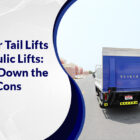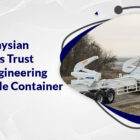Ever imagined how to keep your tail lift in peak condition and avoid unexpected breakdowns? There are different types of Tail lifts for sale available in the market. One such equipment that ensures safe loading and unloading of heavy goods, especially in commercial operations is named as a cantilever tail lift. But without a proper maintenance checklist, these essential pieces of equipment can quickly become a source of trouble.
To help you get the complete advantage of tail lifts at its best, this tail lift maintain guide provides an in-depth guideline to improve overall logistics operations. So, without further ado – let’s dive in!
An Overview of Tail Lift for Commercial Vehicles
Tail lifts are hydraulic-powered platforms attached to the rear of commercial vehicles. They are designed to facilitate the loading and unloading of goods. There are different types of tail lifts for sale that work like a connected bridge between the ground and the vehicle’s cargo area. One such cantilever tail lift allows effective loading of heavy or bulky items without the need for manual lifting.
Speaking of fact; According to the recent report shared by Market Decipher, a global tail lift market is predicted to cross $1609 billion by year 2027.
Moreover, as they come in various sizes + weight capacities – Tail lift uses span across various industries, making them indispensable for logistics, retail, and distribution sectors. To find the best cantilever tail lift for sale in the UAE, reach out to Tusker Engineering for expert guidance.
How to Maintain Tail Lifts in the Right Way?
Wondering how to maintain tail lift to ensure improved safety, efficiency, and longevity? Proper tail lift maintenance not only helps in preventing costly repairs but also enhances the overall performance of your vehicles and logistic operations. Here’s a step by step guide on tail lift maintenance you should not overlook.
Step 1 – Daily Visual Inspection
→ Conduct a thorough visual inspection of the tail lift every day before use.
→ Check for any visible signs of damage, such as dents, cracks, or corrosion on the platform, hinges, and hydraulic components.
→ Inspect all bolts, fasteners, and safety decals to ensure they are securely in place and legible.
→ Look for hydraulic fluid leaks, indicated by puddles or stains beneath the lift, and address any leaks promptly to prevent fluid loss.
Step 2 – Lubrication for Smooth Performance
→ Apply the recommended lubricants to all moving parts, including pivot points, hinges, and hydraulic cylinders.
→ Lubricate according to the manufacturer’s specifications and guidelines to reduce friction, wear, and corrosion.
→ Wipe off excess lubricant to prevent the accumulation of dirt and debris, which can affect the lift’s performance over time.
Step 3 – Hydraulic System Maintenance
→ Monitor the hydraulic fluid levels regularly and top up as needed with the recommended fluid type.
→ Inspect hydraulic hoses, seals, and connectors for signs of wear, cracks, wiring damage or leaks.
→ Replace any damaged or worn-out hydraulic components promptly to prevent system failure and ensure unobtrusive operation.
Step 4 – Required Load Testing
→ When it comes to tail lift maintenance, Conduct load tests to verify the lift’s capacity and performance under typical operating conditions.
→ Gradually put weight on the platform to ensure it can handle its rated load capacity without signs of strain or any error.
→ Monitor the tail lift’s response and operation during the test to identify any potential issues.
Step 5 – Yearly Tail Lift Maintenance Service
→ Schedule an annual comprehensive tail lift maintenance service provided by qualified technicians or an authorised centre.
→ During servicing, conduct detailed inspections, adjustments, and maintenance tasks as per the tail lift manufacturer’s recommendations.
→ An annual tail lift service may include hydraulic system flushing, component replacement, adjustment of lift controls, and overall system calibration to ensure optimal performance and safety compliance.
A Few Signs That Ask for Tail Lift Maintenance ASAP
Here are the signs that indicate an immediate need for tail lift maintenance:
→ Hydraulic fluid leaks.
→ Unusual noises or vibrations during operation.
→ Slow or inconsistent operation.
→ Visible wear, cracks, or rust on the platform.
→ Electrical malfunctions like non-responsive controls or flickering lights.
→ Electrical malfunctions like non-responsive controls or flickering lights.
→ Struggling to operate the tail lift.
→ Safety system faults such as malfunctioning emergency stop buttons.
How to Choose the Best Tail Lift for Your Business?
To conclude, thinking of how to choose the best tail lift for your business? Tusker Engineering stands as a renowned tail lift manufacturer in UAE with extensive experience. We specialise in providing top-quality tail lifts, including versatile cantilever models and other commercial vehicle bodies.
Count on us for unwavering excellence, delivering reliable performance and unmatched durability. Contact our dedicated team today to explore our comprehensive range of solutions tailored to meet your specific requirements.







